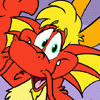
Here's the steps I went through to build Little Cheese, my first fully posable CG character built from scratch.
1. The base mesh. This is what I started with. Created to approximate a human form, note that it has five fingers on each hand.
2. Rough sculpt of basic shape. Working in ZBrush, I sculpted and subdivided the base mesh until the shape roughly matched the proportions of Scott Shaw!'s drawings of Little Cheese. Note that the figure now has four fingers on each hand.
3. Finished sculpt with facial features. Continuing to work in ZBrush, I refined the body further and added details such as eyes, ears, teeth, whiskers and hair. This is the mesh that would be rigged and textured to produced the final, posable character. I used 3d Studio to group and name the mesh for later rigging. Every time I added a new detail I saved a version of the file, just in case of problems. By the end I had over 500 work in progress versions, each a different stage of the character's development.
4. High detail sculpt. Working on a copy of the finished mesh, I subdivided and sculpted further, adding more details. Although the size of this file was too large to make an efficient posable character, the detail was needed for colouring and to produce displacement maps that apply the high detail to the final character without increasing that character's file size.
5. Grouped and rigged figure. Working in Poser Pro, I added the bones and joint edits that allow the figure to bend and move in a believable way. This image shows the internal bones and surface grouping used.
6. Fully posable figure. The finished figure, with posable tail added. Texture maps are used for colour and displacment maps refine the shape, adding detail not present in the posing mesh itself.
7. Texture map used to apply colours onto figure #3 to produce figure #6.
8. Displacement map used to apply details from figure #4 onto figure #3 to produce figure #6.
9. Little Cheese, laying the hurt down on evildoers!
1. The base mesh. This is what I started with. Created to approximate a human form, note that it has five fingers on each hand.
2. Rough sculpt of basic shape. Working in ZBrush, I sculpted and subdivided the base mesh until the shape roughly matched the proportions of Scott Shaw!'s drawings of Little Cheese. Note that the figure now has four fingers on each hand.
3. Finished sculpt with facial features. Continuing to work in ZBrush, I refined the body further and added details such as eyes, ears, teeth, whiskers and hair. This is the mesh that would be rigged and textured to produced the final, posable character. I used 3d Studio to group and name the mesh for later rigging. Every time I added a new detail I saved a version of the file, just in case of problems. By the end I had over 500 work in progress versions, each a different stage of the character's development.
4. High detail sculpt. Working on a copy of the finished mesh, I subdivided and sculpted further, adding more details. Although the size of this file was too large to make an efficient posable character, the detail was needed for colouring and to produce displacement maps that apply the high detail to the final character without increasing that character's file size.
5. Grouped and rigged figure. Working in Poser Pro, I added the bones and joint edits that allow the figure to bend and move in a believable way. This image shows the internal bones and surface grouping used.
6. Fully posable figure. The finished figure, with posable tail added. Texture maps are used for colour and displacment maps refine the shape, adding detail not present in the posing mesh itself.
7. Texture map used to apply colours onto figure #3 to produce figure #6.
8. Displacement map used to apply details from figure #4 onto figure #3 to produce figure #6.
9. Little Cheese, laying the hurt down on evildoers!
Category Artwork (Digital) / Fanart
Species Mouse
Size 960 x 1200px
File Size 478.3 kB
The tail started out as the EZTube prop for Poser. It has 50 segments and some excellent posing dials. But it did have some joint problems that originally prevented me from scaling and tapering it correctly. It took me an afternoon to fix that.
I didn't keep track of the actual time I spent on the whole Little Cheese project. But I did start it in January 2011 and finished in January 2012. Part of that time was spent working on the figure itself during evenings, and part of it on tutorials and testing to learn how to do things I hadn't tried before, like rigging and displacement maps.
I didn't keep track of the actual time I spent on the whole Little Cheese project. But I did start it in January 2011 and finished in January 2012. Part of that time was spent working on the figure itself during evenings, and part of it on tutorials and testing to learn how to do things I hadn't tried before, like rigging and displacement maps.

 FA+
FA+










Comments